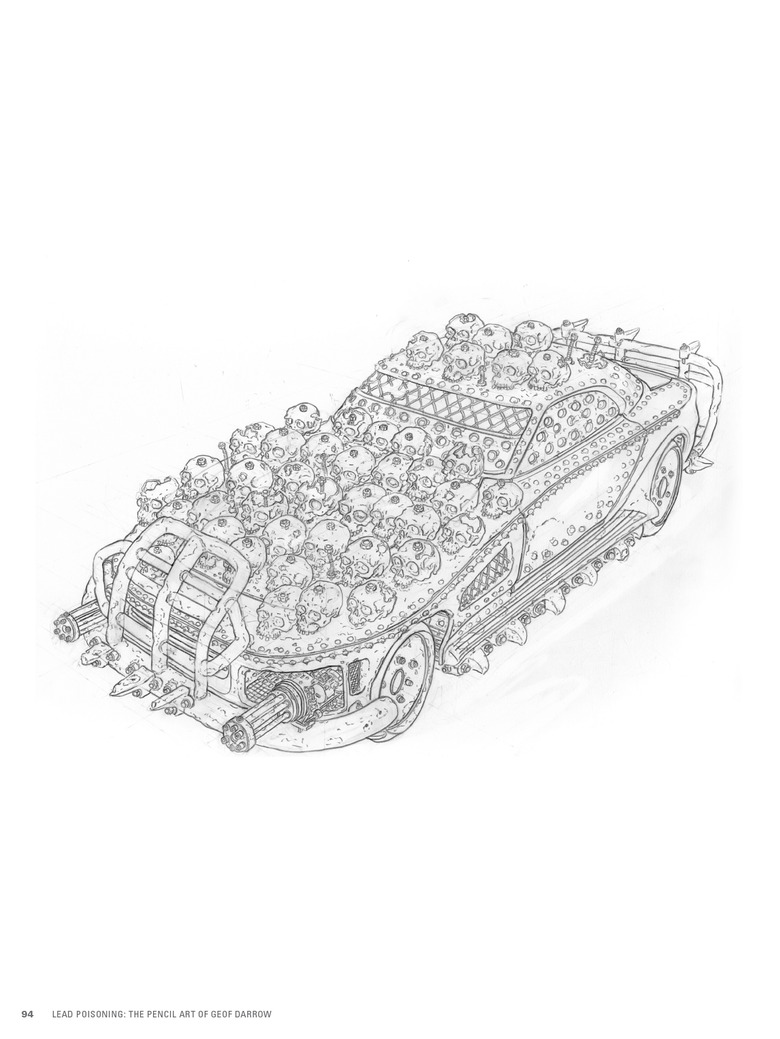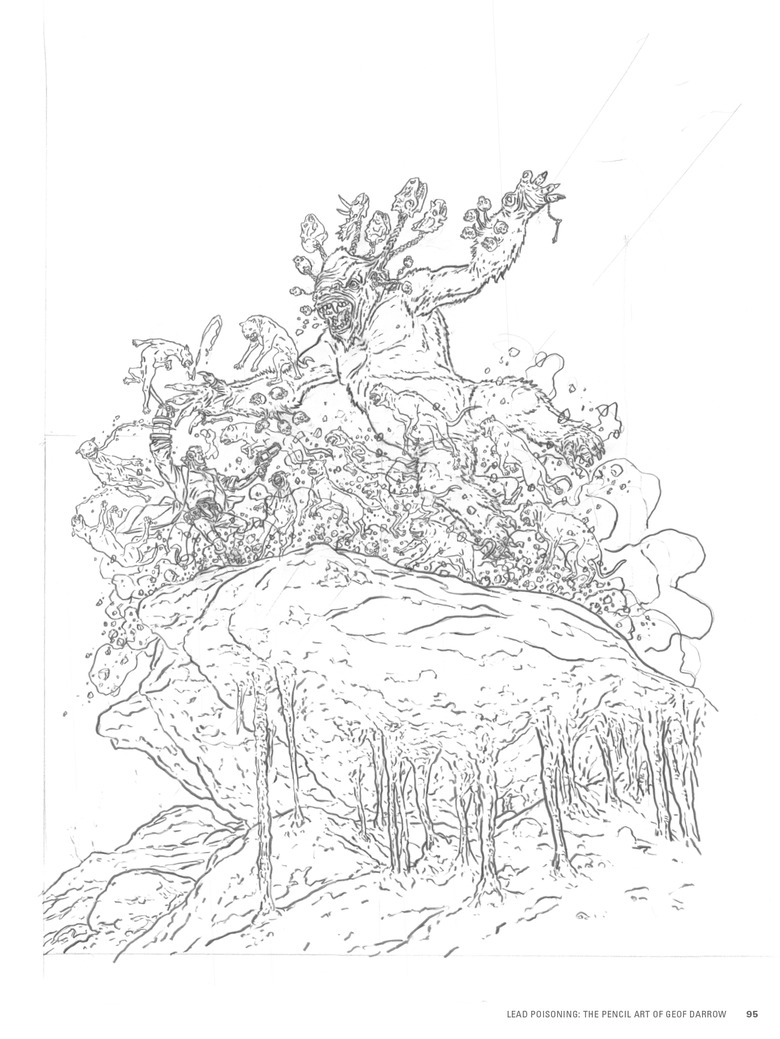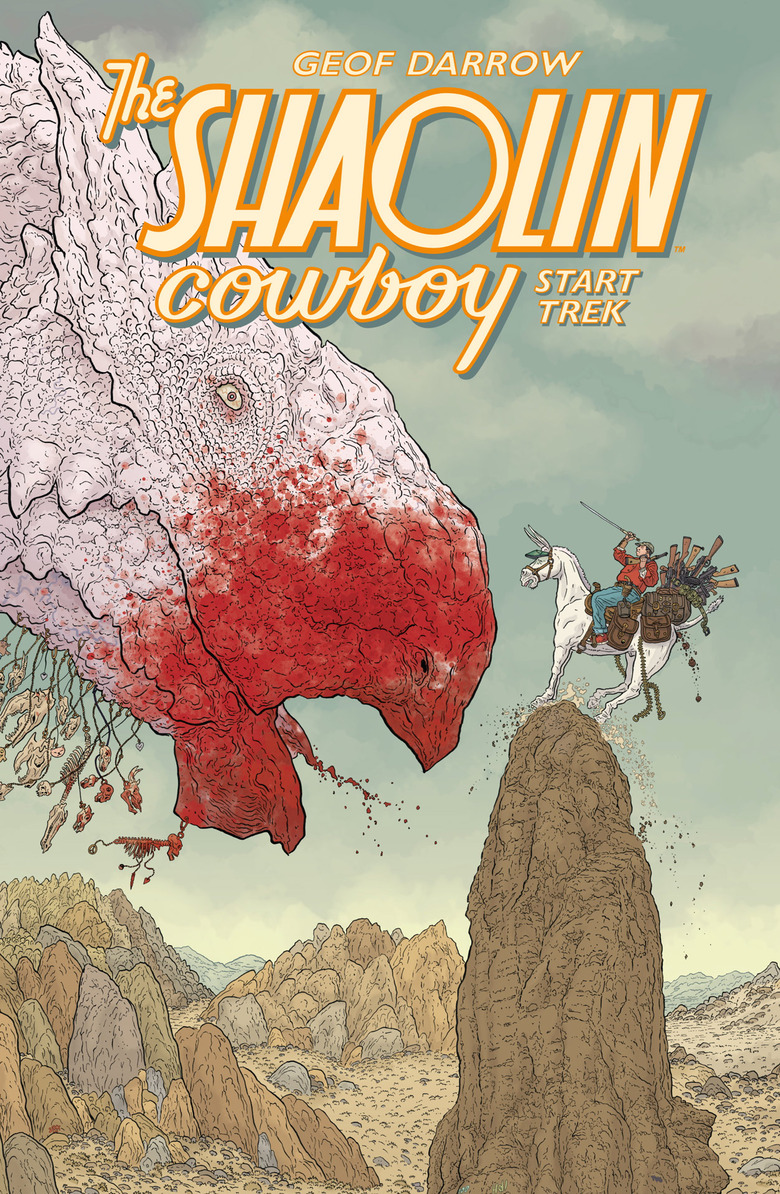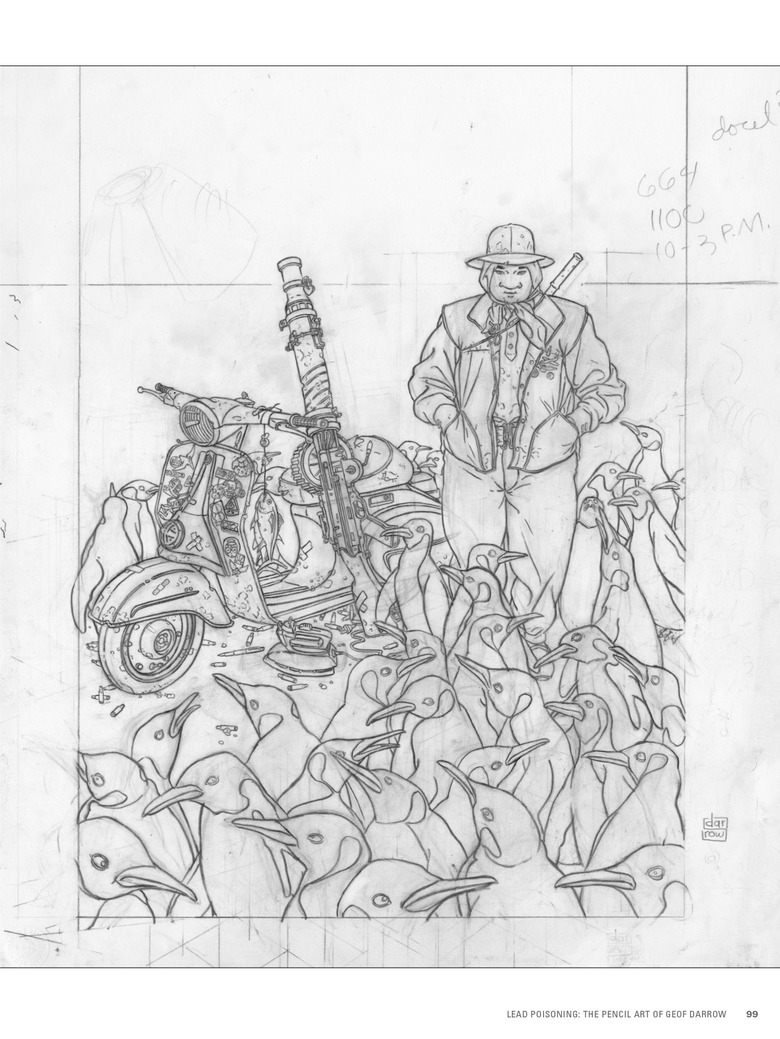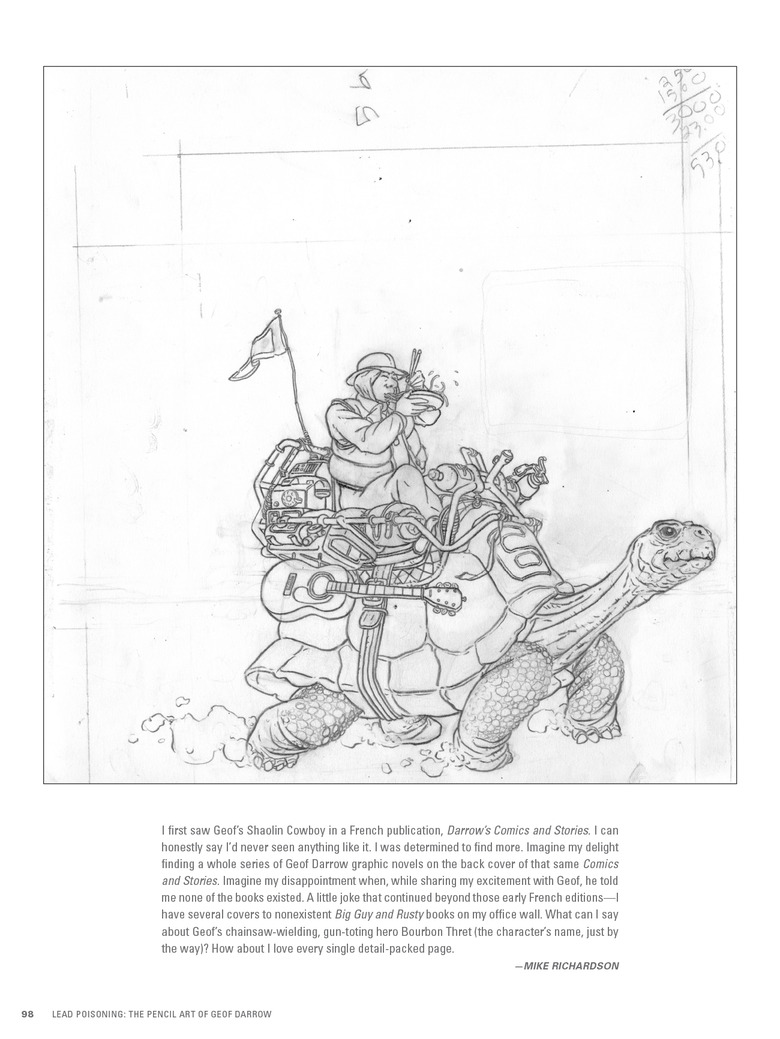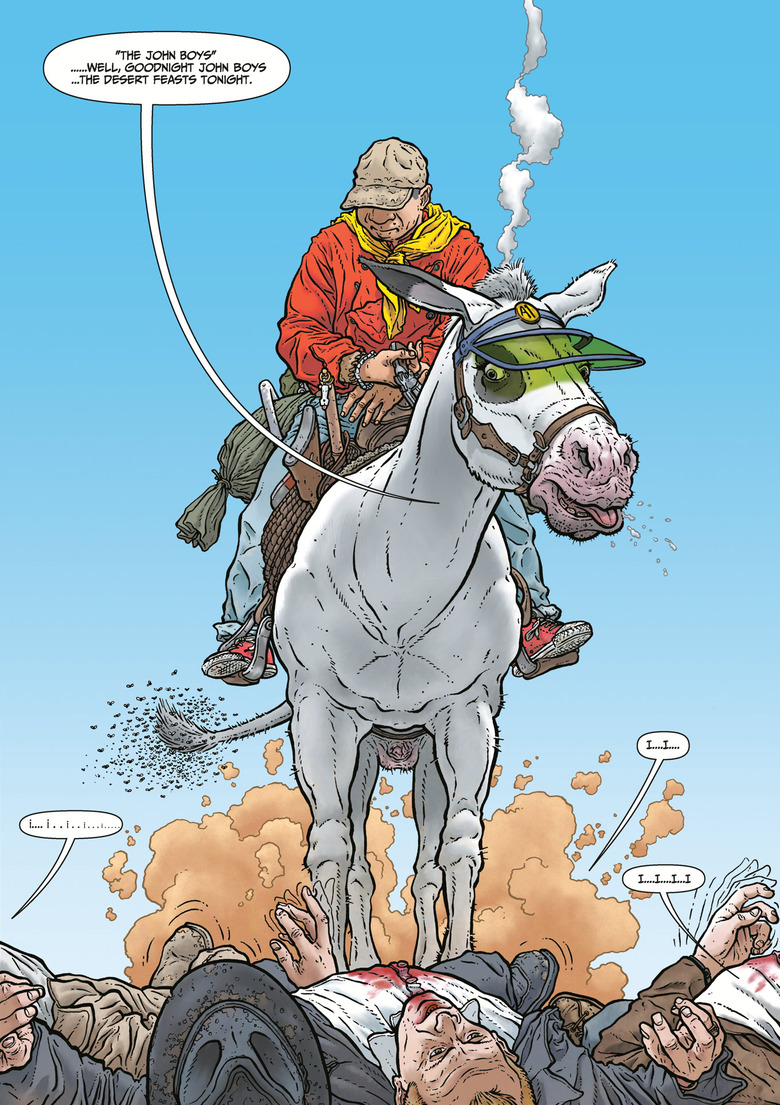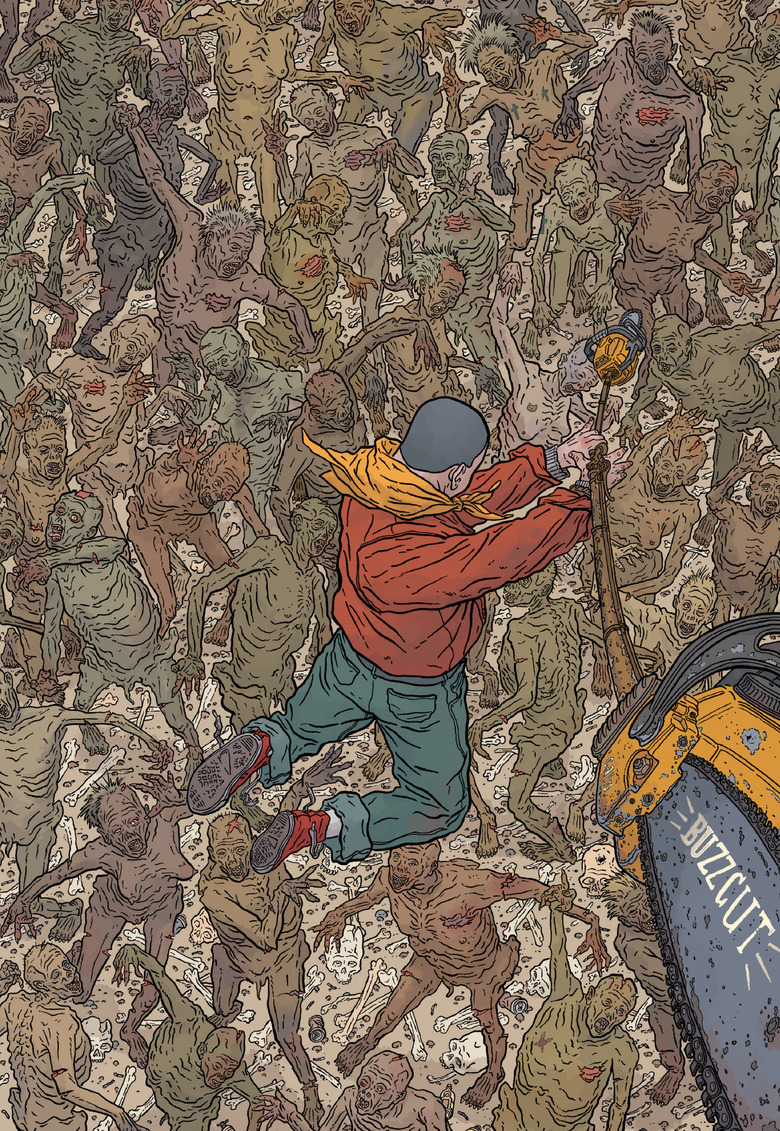Legendary Artist Geof Darrow On Designing For 'The Matrix,' Working With Ridley Scott And His Love Of Making Comics
Geof Darrow has had an enviable career. A career in which he has worked with his icons and grown to call them friends, one that has traversed both cinema and comics, and one that has seen all of his success come from one thing: drawing what he loves.
After decades in the States, Darrow has decided to leave and move back to France, the place that he sees as the birthplace of comics career. I sat down and chatted with Darrow about art, film, friendship, and how he feels he owes his whole career to one man.
A Chance Meeting With An Icon
Darrow's journey into comics history began whilst working at Hanna Barbera when he heard that the astonishing French artist Jean Giraud, AKA Moebius, was in town.
"I'd heard that he was in town working on Tron and I had a friend who was a project manager at Epcot Center at Disney. I thought this guy probably has the juice to get me in into the studio so I can meet Moebius. I was such a huge fan, so I gave my friend Jean's name and he didn't know who he was," Darrow laughed. "A day went by and I didn't hear anything, and then he called and said 'We're going to have dinner with him on Saturday night.' And we went out and saw each other a couple of times and he asked me 'What do you do?' I said 'I draw' and he looked at my drawings and he liked them, so we kept we kept in contact. When I went to France for the first time, he set me up with an interview with Metal Hurlant, which is the the original version of Heavy Metal."
The pair became fast friends and Darrow relocated to create alongside the comics giant.
"That was my first comic story, and they liked it and printed it. A couple of years after when I moved to France to work with Moebius on a comic strip, I was going to draw it and he was going to write it. We started out instead just doing a portfolio, which is like 10 drawings that I drew and he inked and colored, and that kind of put me on the map in France."
"So you know at that point he's so mysterious and hardly anybody has seen him. I mean, I was obviously extremely intimidated because I was a fan and I did these drawings. And when I went over there to work in Paris he was already leaving town because he was going to go live in Tahiti. So he was gone when I started, and I would do these drawings and they would send the drawings to him in Tahiti and he would ink them and so I was never around. I never saw him work on them. It was kind of like a gift, it was just so nice. They'd be like 'He's finished your first drawing.' Holy cow!" Darrow exclaimed. "I think I'm going to try – because I still have the pencil drawings–we're going to put out a book of the drawings with his finishes so that people can see."
"He told me he really liked doing it. He said he was really honored to do it, which surprised me. And he said he couldn't do more than two hours a day because it was so intense that he would get up in the morning and he would work two hours and then he would do his own stuff. So there's one drawing he worked on for one month that took him two or three hours a day. I think I have that one, and I did get to keep one of them, the inked one."
Creating Hard Boiled With Frank Miller
"Through knowing Jean, I got to meet Frank Miller. We kind of hung out. Later he proposed to me that we should work together and that put me on the map in America. I mean, you know Frank at the time had The Dark Knight Returns and Ronin, which were huge, and I started working with him with and he was doing Elektra Lives. So really people looked at what I did because it was Frank writing it."
"I kind of felt that I was extremely lucky in that outside of working at Hanna Barbera and working a little bit in advertising I never really had to work for other people. I've always gotten to kind of draw whatever I wanted."
"I remember sending my first comic strip to Marvel and they said it's good but they wouldn't know what to do with it because in those days, in the '80s, they had to look a certain way. I was working in what they called 'ligne clair,' which is the style that I think Herge and Tintin sort of pioneered. That interested me more than the heavy shadowed stuff because I was always trying to learn how to draw, but if I put shadows on then I won't figure it out. So I would draw everything in line so that they could understand what I was drawing."
The Influences Behind Shaolin Cowboy
Darrow's longest running and probably best known comic work is Shaolin Cowboy. The ongoing story is cinematic in scope, so it's no surprise that some of Darrow's biggest influences are some of cinema's most iconic films.
"I've always been a huge fan and I grew up when every TV show on Earth was a western, so I really liked westerns. I was a big fan of Clint Eastwood on the show Rawhide and Steve McQueen in Wanted: Dead or Alive. Then when Italian westerns came out, those really affected me a lot. In high school, PBS would run this great directors series and they ran this film called Seven Samurai when I was 13. I was like 'Holy cow. Wow.' And then I tried to find everything I could find on Japanese samurai films."
"I was familiar with Godzilla and Astro Boy and all that stuff, but then I saw Yojimbo which is one of my favorite films of all time and then Zatoichi the Blind Swordsman. I was also a young kid when the Kung Fu craze took off, so I was watching Bruce Lee and I love those. So after I finished working with Frank Miller on this comic called The Big Guy, I just wanted to do something that had all that kind of stuff that I like in. I'm a huge fan of Shintaro Katsu who plays Zatoichi, so I kind of based the character on him. I also really like spaghetti westerns. I thought 'I'd really like to make a samurai cowboy!' Samurai Cowboy sounded kind of goofy, but Shaolin Cowboy sounded kind of goofy enough that it might be kind of neat.".
"So I just started drawing it! The idea originally was just giving him various things to hurt people with! In the last one I think he used a pair of dogs like nunchucks to fight off all these guys. I thought it was kind of funny. I mean the whole thing is just about a guy walking and things happen to him."
Darrow's First Foray Into Movies
Darrow has shaped contemporary film culture with his work on The Matrix, but he was first approached by one of the most famous directors of all time to create an adult animation show that sadly never came to be.
"The first thing that I ever worked on movie wise was during the time when The Simpsons was extremely popular. Suddenly all the networks wanted to do an adult show. So I get this call and they said 'Ridley Scott wants you to design an animated film and an animated TV show.' He was so amazing, he called me up and said, 'Hello, Mr. Darrow. This is Ridley Scott.' Then he goes 'I'm a film director' and he gave me his resume! He never assumed that I knew who he was, which I thought was amazing. I know so many guys even in comics who walk in and say 'Do you know who I am?' No, and I don't want to! At that time, he was such a nice and open minded guy. He gave me his home number and told me to call anytime. His assistant said 'Don't ever call him without calling me first.' But Ridley Scott was like, 'Call me. Come to my house. Anytime.' and then he flew me down to the Cannes Film Festival. We went to see Thelma and Louise."
"That was the first time I got asked to work in film. It never happened. I did a couple drawings and that was it was. He'd seen Akira and he said he wanted to do better than that every week! I told him 'Mr. Scott, you're going to have to go to Japan because you don't have those kind of animators in the United States and they're all pretty busy and you're never going to find anybody who can do that much about quality in a week.' He just kept saying 'That's okay, we'll make it happen.' But it never happened."
He also has another film credit, though according to Darrow it's one he'd rather forget!
"Mike Richardson was the producer of Barbwire because it was based his comic books. He asked 'Can we use this thing you drew in Hard Boiled?' He said 'Oh we'll give you this money.' I have no idea how much it was, but it seemed like a lot of money for having to do nothing. I said sure but I didn't want a credit on it. I hate that movie. I think it's the worst. It's Casablanca! A ripoff of Casablanca. Oh, it's so horrible. And I didn't want to go and see it. It was actually Lana Wachowski at the time who said 'You've got to go' and they made me go with them to see it! I'd just started working on The Matrix and it was horrible, they were laughing at me the whole way through."
How He Came to Design The Matrix
Whilst living in France, Darrow took on a job that would change his life and introduce him to some of his closest friends and collaborators, the Wachowski sisters.
"Warner Bros. called me up when I was living in Normandy, France and they said 'We want you to work with the Wachowskis' and I didn't know who they were. They said 'Well, they've done a movie called Bound.' I hadn't seen it. At the time it hadn't actually even come out! But they said 'Oh they wrote the script for a film called Assassins.' I'd seen that and I thought it was interesting, so I said 'Well, send me the script and I'll read it. If I think I can draw what they have in there, I'll do it.' I didn't want to say I could do it if it's something I couldn't draw!"
"He sent me the script and I found out from them later on that I was the only guy that they sent it to, and the studio was outraged that I asked! But the Wachowskis thought it was cool that I asked, and I loved it. I thought it was fantastic, so they flew me out there. We talked about that and then I went back to Normandy and I drew the first few images of film while living in the countryside in France, which was the lowest of low tech places you can imagine for what was at the time one of the most high tech films!"
"I'm actually in the third one if you look for me! I'm triplets. There's a scene where they have these robots with machine guns I designed and they're shooting at the Sentinels, you know those squid things, and I'm piloting each one of those things. In The Matrix, I'm the only guy in the real world that has glasses! And they will often print this picture from that scene. I mean, my head is about the size of an ant but still."
"I always say that it was all their vision, I was just trying to put it on paper. I remember at the time they told me 'You know if this movie gets made people will know exactly what you did in this film.' I thought they would take my drawing and give it to somebody way more qualified who would turn into something that was way better. I remember sitting at the premiere with them [The Wachowskis] the first time and when they show that scene of him plugged in I was like 'Holy Shit!' They actually did what I had drawn, and I remember kind of looking over at them and they leaned forward with these beautiful smiles on their faces like 'See, told ya!' And I was just so flattered that they thought enough of my drawings to actually build that stuff."
"There were others artists, like Steve Skroce who worked with them in comics and he storyboarded so much of that movie, I would guess 70%. But gosh it was just such an adventure because no one believed in it. And it kind of started and stopped, and I worked on it for about three months and they brought us back for another four months and still it wasn't until they got Keanu that they actually greenlit the thing."
"Wow. Watching [Keanu] work. He was such a hard working young man. Wow. He worked so hard, he put his health at risk. Watching him film when he was on the wires and they were yanking him up and down. Yikes! That was amazing to see because I grew up in Iowa, which is kind of a backward place, especially these days. And to think that I was sitting in the back of a truck with them on this freeway that they've built and they're blowing up cars and I'm just thinking holy cow how lucky is that?"
On His Time In Japan
Darrow spent a year living in Japan working on an adaption of his seminal comic that sadly never saw the light of day.
"It was really hard because at the time I was working on an animated version of Shaolin Cowboy. I'd written the script and I went over there to co-direct it, except no one told the other co-director that I was there. So there's a very strange ambience. He'd been lied to and I'd been lied to by a middle party, and on top of that it was about the time the bubble burst. We went into that big recession–the Weinsteins were putting up half the money and the Japanese were putting up half–and the Weinsteins just balked at doing it. So we spent about a year and a half in preparation, I mean a couple years, just all for naught."
"It's still sitting in boxes over there in Tokyo. That was hard. It was hard because I love the country, I visit there like once a year if I can. I love Japan. I love Tokyo. But working there was just such a drain, you know the pressure of trying to do this movie especially, because we were working while I'd found out that the Weinsteins were going to back out and I couldn't tell the Japanese that they were going to get stuck holding the bag. I felt really guilty because they were working in good faith. Eventually it all fell apart."
On Leaving the States
The inciting reason for mine and Darrow's look back at his career is that the creator is leaving the USA. He's heading back to France to be closer to family and return to the country that he feels he owes his career and life to.
"I'm not fleeing the country because of the current political climate, though I can't say that it didn't add some impetus to it. I've been waiting for my wife–she's been working on something and I've been waiting for her to finish it so we could move back. But I have to tell you, when he got elected I was like 'We've gotta get out of here.'"
"I can buy a place in France and I won't have to chase after the mortgage. I'm currently lucky, I mean I've always been able to draw what I wanted, but now I can not worry about about paying the mortgage. And my daughter goes to school in Paris, so I won't be as far from her. I've always liked France. If it wasn't for France, if it wasn't for Moebius, I don't think I'd have the career that I have. I was fortunate enough that I was asked by his wife to be one of the speakers at his funeral. And I said 'I'm a country bumpkin who owes everything to Giraud because if it hadn't been for him I wouldn't have started in comics. Without the help of Giraud I wouldn't have made comics, so I wouldn't have met Frank, if I hadn't met Frank Miller then I wouldn't have done Hard Boiled, and that led to the Wachowskis it was just one thing that all starts with Moebius."
When it comes to why Darrow's had such a long lasting and eclectic career, it really all boils down to one important thing.
"I really just like drawing comics. I'm kind of a caveman. I still just draw things and everybody gets on Photoshop and I don't know if I'm really made for that world. I just like sitting here drawing the things that I draw, and I'm lucky that enough people buy them that I can keep doing it."
"I've always toyed with with thoughts like 'Oh, I've never drawn Batman.' But I just think if I draw Batman–and I really like Batman–but so many people have drawn Batman, and I'll just be one of many guys, right? There's something Moebius told me once when I was having dinner with him and Frank, and at the time Moebius had started drawing the Silver Surfer. He was saying how hard it was because it just wasn't instinctual. He said 'You know, I've always had this wish to to draw a Marvel superhero. I'd keep it in my pocket, and I'd take it out and look at it once in a while, and then put it back. I should've left that wish in my pocket.' It just wasn't what he thought it was. He was much happier doing other things that were more personal. That to me really expressed his philosophy. I don't have a philosophy. My philosophy is drawing stupid stuff that nobody cares about. Well, I like the idea that someone thinks 'Why would anybody spend this much time drawing something this stupid?'"

